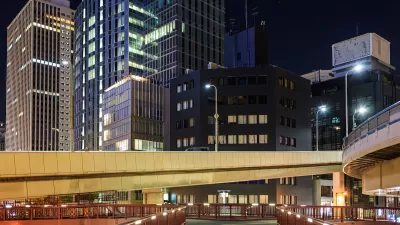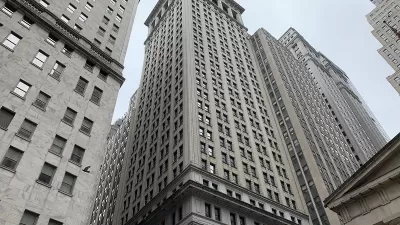A new study by SPUR and the Urban Land Institute’s San Francisco chapter estimates a specific number of apartment units that could be built from vacant office units in the city.

San Francisco is one of the prime examples of downtowns in need of reinvention from office-centric to housing-rich. As documented by recent articles shared by Planetizen, it’s not easy to convert office buildings to residential units, though there’s major potential benefit to identifying the kinds of buildings that can be converted.
Enter a new study by SPUR and the San Francisco Chapter of the Urban Land Institute, detailed in a paywalled article by John King for the San Francisco Chronicle. The two organizations are also hosting an event to dig into the study’s findings in a sold out event on March 28.
The analysis “suggests more than 10,000 housing units could be created within the shells of older office buildings — but only if the city primes the pump by lowering fees and affordable housing requirements,” reports King.
The structures that are the most promising candidates for conversion, according to the summary, are high-rises where the upper floors are no more than 20,000 square feet, roughly equal to the towers of One Market Plaza at the foot of Market Street. There should be an ample number of elevators, and they shouldn’t be too far from the outer windows. There also should be a good mix of views.
The study also includes recommendations for how to make these units make financial sense for developers, including removing or reducing “the current standard that new housing downtown must provide 75 square feet of outdoor space for each residential unit” and removing city requirements that “21.5% of new rental housing must be reserved for lower-income residents.”
“Some changes already are in the works: Mayor London Breed and Supervisor Aaron Peskin on Monday, for instance, announced they’ve crafted a proposed zoning update that would loosen current requirements that all multi-family housing projects include a sizable number of two- and three-bedroom units,” reports King. “It also would allow housing above the first floor of retail buildings in the Union Square district.”
While the full study will be published later this spring, a “Summary of Findings” is already available to read online.
FULL STORY: S.F.’s empty office space could hold 11,000 new homes — but only with City Hall’s help, report says

Planetizen Federal Action Tracker
A weekly monitor of how Trump’s orders and actions are impacting planners and planning in America.

Chicago’s Ghost Rails
Just beneath the surface of the modern city lie the remnants of its expansive early 20th-century streetcar system.

San Antonio and Austin are Fusing Into one Massive Megaregion
The region spanning the two central Texas cities is growing fast, posing challenges for local infrastructure and water supplies.

Since Zion's Shuttles Went Electric “The Smog is Gone”
Visitors to Zion National Park can enjoy the canyon via the nation’s first fully electric park shuttle system.

Trump Distributing DOT Safety Funds at 1/10 Rate of Biden
Funds for Safe Streets and other transportation safety and equity programs are being held up by administrative reviews and conflicts with the Trump administration’s priorities.

German Cities Subsidize Taxis for Women Amid Wave of Violence
Free or low-cost taxi rides can help women navigate cities more safely, but critics say the programs don't address the root causes of violence against women.
Urban Design for Planners 1: Software Tools
This six-course series explores essential urban design concepts using open source software and equips planners with the tools they need to participate fully in the urban design process.
Planning for Universal Design
Learn the tools for implementing Universal Design in planning regulations.
planning NEXT
Appalachian Highlands Housing Partners
Mpact (founded as Rail~Volution)
City of Camden Redevelopment Agency
City of Astoria
City of Portland
City of Laramie





























